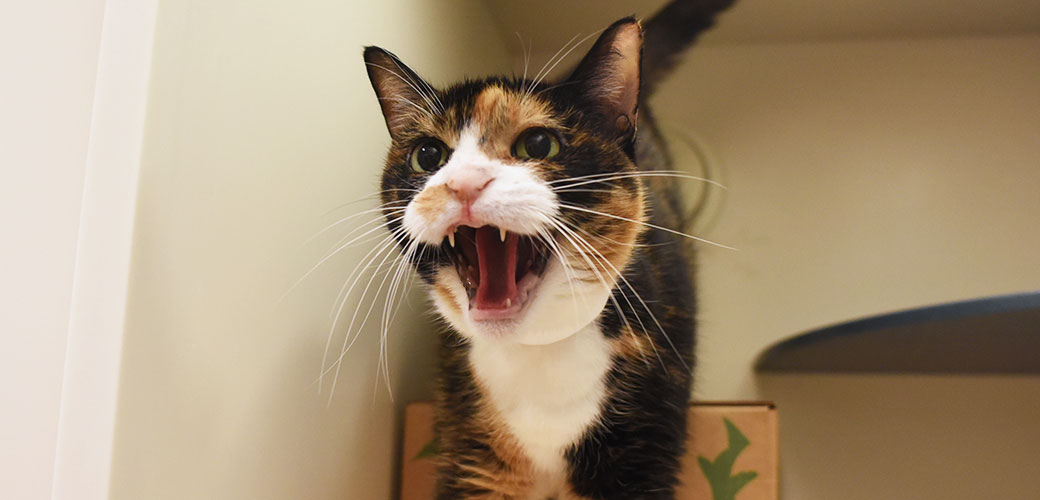
Aggression in Cats

Aggression is the second most common feline behavior problem seen by animal behaviorists. Although cat aggression is sometimes taken less seriously than dog aggression—perhaps because cats are smaller and don’t pursue people to bite them—aggressive cats can be formidable. They have five potential weapons (their teeth and all four clawed paws) compared to a dogs’ sole weapon of his or her mouth. Cats can bite and inflict severe lacerations, which are painful and can easily become infected. They can also cause cat scratch fever, a usually benign but potentially serious infectious disease that causes flu-like symptoms. Fights between cats rarely result in fatalities, but they can lead to infections and result in considerable veterinary expenses for cat parents. Aggressive cats can be risky to have at home and can pose a real danger to family and visitors.
What Is Aggression?
Aggression is threatening or harmful behavior directed toward a person, another cat or other animals. Virtually all wild animals display aggression to guard their territories, defend their offspring and protect themselves if attacked. Aggression refers to a wide variety of complex behaviors that occur for different reasons under various circumstances. In pet cats, aggressive behavior can range from cats who hiss and avoid the target of their aggression to cats who attack.
Understanding Cat Body Language
Understanding what cats are communicating through their body language is essential for cat parents. It enables them to more accurately “read” their cats and understand their feelings and motivations for doing what they do. It also helps them respond more effectively to behavior issues like aggression.
Body language is made up of cats’ body postures, facial expressions, and the position and carriage of certain body parts, like ears, tail and even whiskers. Cat body language is more subtle than dog body language and can be harder for people to interpret. Knowing the basic postures and what they mean can help cat parents deal with problems more effectively and enjoy their cat’s company more fully because they can understand a common language.
Threats and aggression can be either offensive or defensive. An offensively aggressive cat tries to make himself look bigger and more intimidating, whereas a defensively aggressive cat adopts a self-protective posture and tries to make himself look smaller. The following are typical postures seen in feline aggression. A rule of thumb is to not touch, attempt to reassure, or punish cats showing these postures!
Offensive postures include:
A stiff, straight-legged upright stance
Stiffened rear legs, with the rear end raised and the back sloped downward toward the head
Tail is stiff and lowered or held straight down to the ground
Direct stare
Upright ears, with the backs rotated slightly forward
Piloerection (hackles up), including fur on the tail
Constricted pupils
Directly facing opponent, possibly moving toward him
Might be growling, howling or yowling
Defensive postures include:
Crouching
Head tucked in
Tail curved around the body and tucked in
Eyes wide open with pupils partially or fully dilated
Ears flattened sideways or backward on the head
Piloerection (hackles up)
In an anxious cat, whiskers might be retracted. In a fearful cat, whiskers might pan out and forward to assess distance between himself and the danger
Turning sideways to the opponent, not straight on
Open-mouthed hissing or spitting
Might deliver quick strikes with front paws, claws out
Overt aggression, whether defensive or offensive, includes:
Swatting, striking with paws
Biting
Fighting
Growling, shrieking
Scratching
Preparing for an all-out attack by rolling onto side or back and exposing all weapons: teeth and claws
In this position, your cat might attempt to grab your hand and bring it to his mouth to bite it
Classification of Aggressive Behavior
If your cat has been aggressive in the past or you suspect he could become aggressive, take time to evaluate the situations that got him upset. Who did he aggress toward? When and where did it happen? What was going on during the half-hour or so leading up to the incident? What was about to happen to your cat? Determining the answers to these questions can clarify the circumstances that trigger your cat’s aggressive reaction and provide insight into why he’s behaving this way. You need to understand the cause of your cat’s aggression and his motivation for it before you can help him.
Keep in mind that a number of medical conditions can cause or contribute to your cat’s aggression, including toxoplasmosis, hyperthyroidism, epilepsy, abscesses, arthritis, dental disease, rabies, trauma, and sensory decline or cognitive dysfunction in older cats. The first step in resolving your cat’s aggression problem is to have a complete veterinary exam to assess his physical health.
Aggressive behavior problems in cats can be classified in different ways. A good way to understand why your cat is aggressive is to think about the function or purpose of the aggression. If you consider all the reasons why cats behave aggressively, you can determine what motivates your cat to do so and identify what he might gain.
Fearful or Defensive
Fear aggression can occur when a cat perceives a threat, and it escalates if he can’t escape. The more threatening the person, animal, object or sound seems to the cat, the more heightened his fear reaction will be. Typical body postures associated with fearful or defensive aggression are a combination of defensive signals (such as crouching, flattening the ears, tucking the tail, leaning away or rolling onto the side, and pupil dilation) and aggressive signals (such as hissing and spitting, piloerection, growling, swatting, biting and scratching). Aggressive signals are especially likely to be displayed if a cat can’t escape the thing he fears. Often the best way to deal with a defensively aggressive cat is to simply avoid him until he calms down.
Redirected
Redirected aggression is probably the most dangerous type of cat aggression because the bites are uninhibited and the attacks can be frightening and damaging. Unfortunately, it’s also a very common type of feline aggression. Redirected aggression occurs when a cat is aggressively aroused and agitated by an animal or person he can’t get at (because there’s a window between them, for example). Unable to get to the trigger of his agitation, he turns and lashes out at someone—person, dog or cat—who is nearby or who approaches him. There can be considerable delay between the initial arousal and the redirected aggression, as long as hours. This is why cat parents sometimes describe this kind of aggression as unprovoked or “out of the blue.” They weren’t even aware of the initial trigger (for example, a cat outside who passed by 30 minutes before the attack). A redirected attack occurs only if an agitated cat is approached or there’s someone close by. The cat won’t go looking for someone to attack! It’s not a malicious or even intentional type of aggression. It’s almost like a reflex, done automatically without thought. This is why it’s never a good idea to break up a cat fight or approach an agitated cat showing defensive or offensive aggression postures.
Some common triggers for redirected aggression are:
Watching another cat through a door or window
Watching or stalking birds, squirrels or other prey animals
Smelling another cat’s odor on a family member, a visitor or clothing
Coming indoors after getting outside if the cat usually lives only indoors
Hearing high-pitched noises
Being frightened or harassed by a dog
Having a person intervene in a cat fight
Being in an animal shelter, surrounded by the sight, smell and sounds of other.
Idiopathic
The classification of idiopathic aggression includes any type of aggression whose cause can’t be determined or explained through behavior history or medical exam. Cats with this type of aggression can attack their owners violently. They may bite repeatedly and remain in an aroused state for long periods of time. Redirected aggression must be closely considered and ruled out as a possible cause before a diagnosis of idiopathic aggression is made. These cats are dangerous, and pet parents of such cats should carefully assess their quality of life, as well as the safety of those around them.
Predatory
Cats are predators, and predatory behaviors are completely natural and highly motivated behaviors for them. Many experts don’t classify predation as aggression because its purpose is to obtain food—unlike other types of aggression, which are responses to conflict. Cats are superb hunters. They use their acute vision and sensitivity to high-pitched sounds to locate their prey. They hunt insects, reptiles, rodents, young rabbits and birds. Most cats specialize in rodents, such as mice and voles, but a few become good at killing birds. When a cat detects potential prey, his predatory sequence of behaviors starts with silent stalking, watching and waiting for the perfect moment to strike (his rear end might wobble from side to side and his tail might twitch). Then he’ll finally sprint toward the prey and strike it with his front paws. If he’s successful, he’ll deliver a killing bite that all cat species use—he’ll bite the prey at the back of the neck to sever the spinal cord. If your cat likes to watch out the windows, you may have seen him become focused, twitch the end of his tail and move his mouth to make a strange chattering sound. When cats do this, it’s because they’ve detected prey that they’d like to hunt.
Nathalie furnesさんをフォローして最新の投稿をチェックしよう!
0 件のコメント
この投稿にコメントしよう!
この投稿にはまだコメントがありません。
ぜひあなたの声を聞かせてください。
